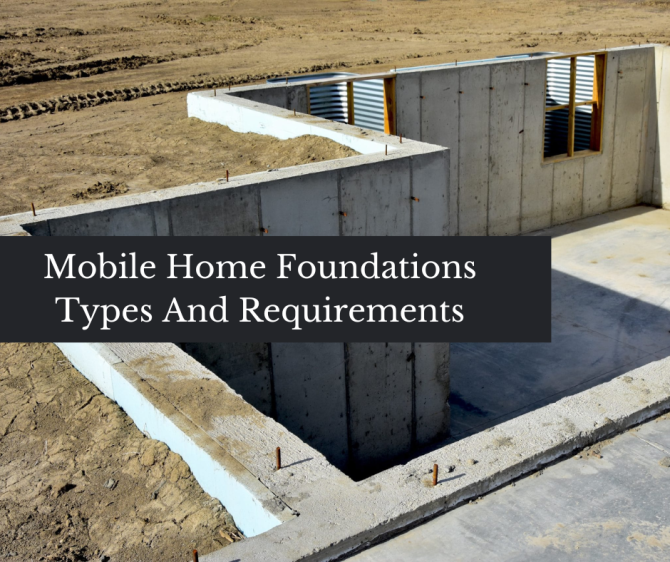Selecting the best foundation for your mobile home requires carefully weighing the benefits and drawbacks of each choice while considering location and the permits needed for home modifications. Understanding mobile home foundation requirements is essential to ensure stability, safety, and compliance with local regulations.

Permanent and non-permanent are the two main types of foundations for mobile homes. However, local regulations may have different definitions of a permanent foundation. If you're wondering if you can put a mobile home on a foundation, the answer is yes, provided it meets the necessary legal and structural criteria. Keep reading to explore the different foundations for mobile homes and determine which one best fits your needs.
Types of Mobile Home Foundations
1. Pier and Beam Foundation
One of the most widely used kinds of mobile home foundations is this one. Anchors are used to secure your house to the pier and beam foundation, and steel straps are used to join them to the beams of the frame, which are usually composed of concrete. The beams are attached to a slab of concrete. It's critical to understand how to choose a foundation repair contractor because pier and beam foundations have the potential to settle over time.
| Pros | Cons |
| Provides a crawlspace for easy access to plumbing and electrical lines | May develop leveling issues over time |
| Reduces the risk of flooding due to elevation | Less visually appealing compared to other foundation types |
| Easier and often less expensive to repair than a concrete slab foundation | Typically, it has a lower resale value |
| Can be relocated more easily if needed |
2. Slab Foundations
A slab foundation is different than a pier and beam. While the pier and beam foundation has a crawl space underneath, a slab foundation is made of concrete with no space. Also, a slab foundation is made of 4-6 inches of concrete on top of a layer of sand for drainage.
This type of foundation allows for a basement in the home. Basement foundations are usually at least 7 feet high, the deepest of all foundations, and match the amount of square footage above it. The advantages are that it increases energy efficiency,is a multi-purpose space, and families enjoy this living area in the home.
| Pros | Cons |
| Low cost | Not safe on steep slopes |
| Quick and easy construction | Poor insulation against freezing weather |
| Safe for earthquakes and floods |
Read also: Cost of Permanent Foundation for a Manufactured Home
3. Crawl Space Foundations
“A crawl space is an unoccupied, unfinished, narrow space within a building, between the ground and the first (or ground) floor. The crawl space is so named because there is typically only enough room to crawl rather than stand.” This type of shallow foundation primarily creates a protective buffer between the ground and the wooden structure of the home or building. It also allows easy access to repair plumbing, electrical, and HVAC systems.
Crawl space foundations are more typically found in warmer regions where there is no frost line to contend with. But crawl space foundations can be found anywhere if it’s an older period home because at one time, that was all they made.
| Pros | Cons |
| Easy access to plumbing and electrical for repairs | Requires ongoing maintenance |
| Easier to add home extensions | Leaks under the home may go unnoticed |
| Lower foundation repair and leveling cost |
Higher risk of drainage issues, mold, and musty odors |
4. Full Basement Foundations
Basement foundations, which are most frequently found in conventional stick-built homes, are the most reliable foundation for a modular home. These concrete-poured foundations need to match the dimensions of your house. In almost every municipality, they must first be inspected and approved by the building department of the local municipal authority before being sold.
Basements are a long-term solution that provides homeowners with more living space and a conventional home appearance, which makes them very appealing.
| Pros | Cons |
| Increases home value | Higher cost than other foundations |
| Provides extra living or storage space | Longer construction time |
| Offers better protection from extreme weather | More code requirements and inspections |
Mobile Home Foundation Requirements
Your mobile home foundation must meet certain eligibility requirements to qualify for financing. Several of the most common are outlined here:
- The foundation must meet the guidelines described in HUD’s Permanent Foundations Guide for Manufactured Housing.
- The foundation must be certified by a professional engineer to meet the standards set by HUD, or the Federal Housing Administration (FHA) or US Department of Veterans Affairs (VA).
- The home must be on a permanent foundation to qualify for purposes of obtaining an FHA loan or a VA loan.
Read also: Investing in Mobile Homes in 2025: Pros & Cons
How To Choose The Best Mobile Home Foundation
1. Determine the size of your home: Consider how much support and weight balancing you may need, as well as if your land is level or sloped. Determine if additional living or storage space is desired or possible in your area.
2. Pick a type of loan: Decide if you’ll be applying for an FHA, VA, or conventional loan. Determine what, if any, housing or loan assistance is available to you based on local or federal government programs, and which you may be applying for.
3. Research requirements: Look into specific state, local, and agency eligibility requirements. Find out whether your preferred mobile home foundation type is compatible with them. Determine which construction professionals in your area are qualified and capable of your desired specifications.
4. Compare costs: Draw up a budget and price out different manufactured home foundation types. Weigh the pros and cons of each and consider which makes the most financial sense based on your home, location, individual needs, and financial situation. Don’t forget to factor in installation time and cost as you perform these calculations.
Manufactured Homes Regulation in Different States
California
According to California manufactured housing regulations, you can choose among different types of foundations. Frost-protected shallow foundations are increasingly common and are approved by the IRC. These foundations offer a significant advantage to manufactured home installations because they obviate the need to dig to the frost line while avoiding the problems that might arise with floating slabs.
Oregon
According to the Oregano manufactured housing regulations, acceptable types of foundations should incorporate the foundation footing, pier, and shimming requirements into one device.
Foundation materials made from wood or wood by-products exposed to excess moisture, such as under open porches and decks, shall be cedar, redwood, pressure-treated lumber, or wood-polymer composite. Besides that, Piers shall be capable of transmitting the vertical live and dead loads to the foundation below. Every pier shall be supported by a footing.
Washington
Here are the minimum foundation structural requirements based on Washington manufactured housing regulations:
-
The concrete pad, or footing, must be placed on firm and level ground.
-
The support piers must be 8” x 8” x 16” concrete blocks and placed as follows: There must be at least 12 inches of clearance from the bottom of the steel beam to the ground. If the support piers are 3 feet high or less, you can use a single stack.
-
The gap between the pier cap and the steel beam can be filled with wood that is not more than 2x material.
-
The wood shims used to level the home must be 4 to 6 inches long and a maximum of 1½ inches thick.
New Mexico
Just like is the case with most states, New Mexico manufactured housing regulations include the existence of the following items for the purchasing of a manufactured home in this state:
-
Permits
-
Site work
-
Non-permanent foundations
-
Permanent foundations
-
Water supply and testing
-
Anchoring
-
Retaining walls
-
Installation of fireplaces and wood-burning stoves
-
Drainage systems
-
Electrical supply and systems
-
Connection to LP and Natural gas
Arizona
According to Arizona manufactured housing regulations, each manufactured home shall have provisions for support/anchoring or foundation systems that will resist overturning and lateral movement (sliding) of the manufactured home as imposed by the respective design loads.
The manufacturer of each home is required to make provision for the support and anchoring systems but is not required to provide the anchoring equipment or stabilizing devices. The anchoring equipment should be certified by a registered professional engineer or architect to resist these specified forces in accordance with testing procedures.
Not sure which foundation type to choose for your manufactured home? At Homes Direct, we will help you discover the best option based on the specific features of the area you’re going to locate your manufactured home. Contact us, and let’s discuss the details together!


